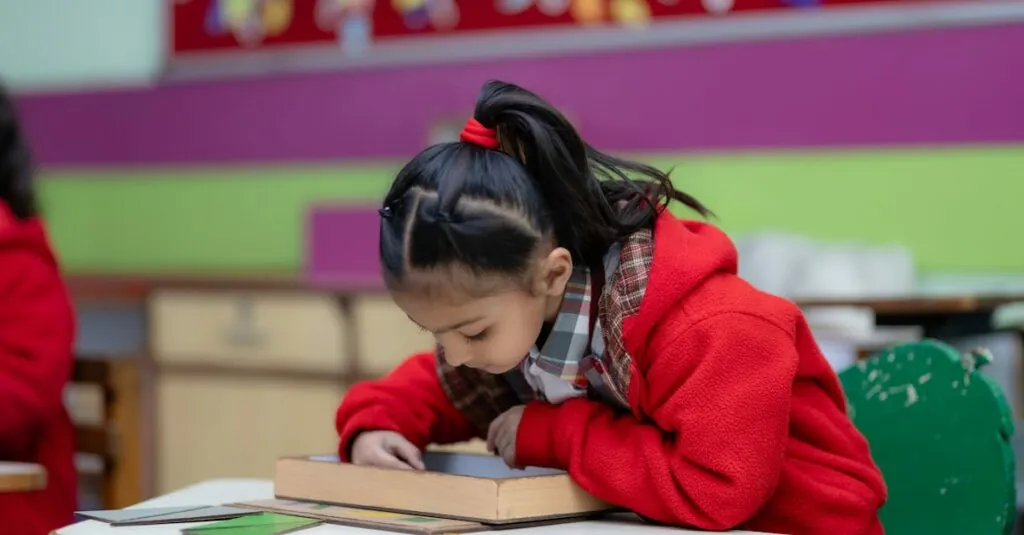Table of Contents
ToggleWhen it comes to education, parents often find themselves at a crossroads: Montessori school or public school? It’s like choosing between a gourmet meal and a fast-food burger—both have their merits, but one might just leave a better taste in your mouth. Montessori schools offer a unique approach, emphasizing independence and hands-on learning, while public schools bring the classic curriculum and a diverse social environment.
Overview of Montessori Schools
Montessori schools emphasize personalized education and foster independence in students. They provide a distinct alternative to traditional public schooling.
Philosophy and Principles
Montessori education revolves around the belief that children thrive when allowed to explore their interests. This child-centered approach promotes self-directed learning. Teachers act as facilitators, guiding students rather than dictating lessons. Respect for a child’s natural development plays a crucial role in this philosophy. The curriculum adapts to each learner’s pace, ensuring that all students engage authentically. Montessori methods often lead to improved critical thinking and problem-solving skills.
Learning Environment
The learning environment in Montessori schools reflects their educational philosophy. Classrooms feature mixed-age groups, allowing younger students to learn from older peers. Materials are tangible and accessible, promoting hands-on exploration. Natural lighting and open spaces encourage a sense of community and collaboration. Students engage in activities that cater to their interests, fostering a love for learning. This environment nurtures a child’s innate curiosity and creativity, making education a fulfilling experience.
Overview of Public Schools
Public schools play a vital role in the education system, serving a diverse student body. They provide foundational education and prepare students for future academic and career pursuits.
Educational Structure
Public schools operate within a standardized framework set by state governments. Students typically attend based on their residential address, promoting neighborhood interaction and community ties. Grades range from kindergarten through 12th grade, encompassing elementary, middle, and high school levels. Teachers usually hold state certification, ensuring the delivery of a consistent quality of education. Class sizes can vary, affecting the amount of individual attention students receive. Many schools offer special education services catering to students with diverse needs, ensuring inclusivity within the classroom environment.
Curriculum Standards
Curriculum standards in public schools align with state guidelines and national frameworks. Core subjects such as mathematics, science, language arts, and social studies receive focus, with educational goals defined for each grade level. State assessments often gauge student progress, establishing a system of accountability. Electives like art, music, and physical education enrich students’ educational experiences. Schools also integrate technology into lessons, equipping students with skills relevant in today’s digital world. Programs for advanced learners, such as honors or Advanced Placement courses, provide opportunities for academic growth.
Key Differences Between Montessori School and Public School
Montessori schools and public schools differ significantly in their approach to education. Each has unique attributes that suit varying student needs and family values.
Teaching Methods
Montessori education employs hands-on, experiential learning methods. Students often engage with tangible materials that enhance understanding. Teachers function as guides, allowing children to explore subjects at their own pace. In contrast, public schools emphasize a structured curriculum that adheres to state guidelines. Lessons typically focus on standardized testing and core subjects like math and science. Teachers lead instruction through direct lectures and assessments. This distinction in teaching methods affects student engagement and learning outcomes.
Student Autonomy
Montessori schools encourage significant student autonomy. Learners choose activities based on their interests, promoting independent decision-making. This flexibility fosters creativity and critical thinking. Public schools, however, provide less autonomy. Students usually follow a fixed class schedule with limited choices. This structure may support routine but often restricts exploration. Consequently, the level of student engagement and motivation differs between these educational settings.
Pros and Cons of Montessori Schools
Montessori schools offer distinct advantages and challenges when compared to traditional public schools. Understanding these factors helps parents make informed decisions.
Benefits
Montessori schools promote individualized learning, allowing students to progress at their own pace. Students engage in hands-on activities that spark curiosity and foster creativity. Classrooms emphasize collaboration among mixed-age groups, encouraging peer learning and social growth. Additionally, teachers serve as facilitators rather than traditional instructors, nurturing critical thinking and problem-solving skills. This educational approach often results in a love for learning and a sense of independence. Whiteboards, art supplies, and tactile learning materials provide stimulating environments for exploration.
Challenges
Montessori schools may encounter challenges related to accessibility and familiarity. Not all areas offer these educational options, limiting opportunities for interested families. Curriculums can vary significantly between institutions, leading to inconsistent educational experiences. Some critics argue that the lack of structure can hinder preparation for standardized testing, which remains important in public schooling. Financial considerations often arise, as Montessori programs may require tuition that disengages low-income families from the benefits. Moreover, parents unfamiliar with this approach may struggle to adapt their expectations regarding education methods.
Pros and Cons of Public Schools
Public schools offer a variety of advantages and challenges that impact students’ educational experiences.
Benefits
Diverse student populations enhance social skills and cultural awareness. Engaging with peers from various backgrounds builds empathy and collaboration. Structured environments support consistency in learning and discipline. Access to special education services ensures support for students with various needs. Extracurricular activities provide opportunities for personal growth, including sports, arts, and clubs. Additionally, public schools often receive funding for technology, equipping students with essential digital literacy skills.
Challenges
Limited resources can hinder educational quality in some public schools. High student-to-teacher ratios might restrict personalized attention. Standardized testing pressures often dominate curriculum planning, emphasizing rote memorization over critical thinking. Variability in school performance can lead to discrepancies in educational outcomes across districts. Budget constraints may result in reduced extracurricular options or outdated materials. Moreover, administrative changes can sometimes affect stability and focus within schools.
Choosing between Montessori schools and public schools involves weighing unique benefits and challenges. Montessori education fosters independence and creativity through hands-on learning experiences while public schools provide a structured environment that promotes community engagement and diverse social interactions.
Ultimately, the right choice depends on a child’s individual needs and learning style. Parents should consider factors like educational philosophy, available resources, and long-term academic goals. By aligning their choice with their child’s interests and strengths, parents can ensure a fulfilling educational journey that sets the foundation for future success.







